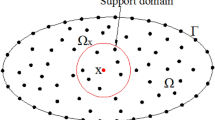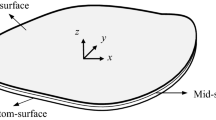Abstract
This article aims to study the free vibration, buckling and bending behaviours of the functionally graded triply periodic minimal surface (FG-TPMS) microplates using isogeometric approach. The study encompasses a comprehensive analysis of three TPMS plate models, namely the Primitive, Gyroid, and I wrapped package-graph, with two distinct density distribution patterns across the plate thickness. The governing equations for the analysis are derived by combination of the Hamilton principle with both the high-order shear deformation theory and the modified strain gradient theory (MSGT). According to the higher-order derivatives and continuous basis functions of the isogeometric analysis, the displacement fields and the high-order strains of MSGT models are accurately approximated. To demonstrate the precision and advantages of the proposed model, a comparison is made between the obtained results and reference results in the literature. The present work further investigates the effect of the length scale parameters, TPMS geometries, density distribution patterns and geometries on the natural frequency, critical buckling load and deflection of the FG-TPMS microplates.










Similar content being viewed by others
References
Jung Y, Torquato S (2005) Fluid permeabilities of triply periodic minimal surfaces. Phys Rev E 72(5):056319
Torquato S, Donev A (2004) Minimal surfaces and multifunctionality. Proc R Soc London Ser A Math Phys Eng Sci 460(2047):1849–1856
Torquato S, Hyun S, Donev A (2003) Optimal design of manufacturable three-dimensional composites with multifunctional characteristics. J Appl Phys 94(9):5748–5755
Sychov M, Lebedev L, Dyachenko S, Nefedova L (2018) Mechanical properties of energy-absorbing structures with triply periodic minimal surface topology. Acta Astronaut 150:81–84
Zhang L, Feih S, Daynes S, Chang S, Wang MY, Wei J et al (2018) Energy absorption characteristics of metallic triply periodic minimal surface sheet structures under compressive loading. Addit Manuf 23:505–515
Tran P, Peng C (2021) Triply periodic minimal surfaces sandwich structures subjected to shock impact. J Sandwich Struct Mater 23(6):2146–2175
Yang W, An J, Chua CK, Zhou K (2020) Acoustic absorptions of multifunctional polymeric cellular structures based on triply periodic minimal surfaces fabricated by stereolithography. Virtual Phys Prototyp 15(2):242–249
Hussain I, Al-Ketan O, Renda F, Malvezzi M, Prattichizzo D, Seneviratne L et al (2020) Design and prototyping soft–rigid tendon-driven modular grippers using interpenetrating phase composites materials. Int J Robot Res 39(14):1635–1646
Zhu L, Li L, Li Z, Shi J, Tang W, Yang J et al (2019) Design and biomechanical characteristics of porous meniscal implant structures using triply periodic minimal surfaces. J Transl Med 17(1):1–10
Yuan L, Ding S, Wen C (2019) Additive manufacturing technology for porous metal implant applications and triple minimal surface structures: a review. Bioactive materials 4:56–70
Elmadih W, Syam WP, Maskery I, Chronopoulos D, Leach R (2019) Mechanical vibration bandgaps in surface-based lattices. Addit Manuf 25:421–429
Altintas G (2018) Vibration properties of TPMS based structures. Int J Sci Technol Res 4:27–42
Simsek U, Arslan T, Kavas B, Gayir CE, Sendur P (2021) Parametric studies on vibration characteristics of triply periodic minimum surface sandwich lattice structures. Int J Adv Manuf Technol 115:675–690
Abueidda DW, Bakir M, Al-Rub RKA, Bergström JS, Sobh NA, Jasiuk I (2017) Mechanical properties of 3D printed polymeric cellular materials with triply periodic minimal surface architectures. Mater Des 122:255–267
Yu S, Sun J, Bai J (2019) Investigation of functionally graded TPMS structures fabricated by additive manufacturing. Mater Des 182:108021
Zhang C, Jiang Z, Zhao L, Guo W, Jiang Z, Li X et al (2021) Mechanical characteristics and deformation mechanism of functionally graded triply periodic minimal surface structures fabricated using stereolithography. Int J Mech Sci 208:106679
Simsek U, Akbulut A, Gayir CE, Basaran C, Sendur P (2021) Modal characterization of additively manufactured TPMS structures: comparison between different modeling methods. Int J Adv Manuf Technol 115:657–674
Viet N, Zaki W (2021) Free vibration and buckling characteristics of functionally graded beams with triply periodic minimal surface architecture. Compos Struct 274:114342
Ejeh CJ, Barsoum I, Al-Rub RKA (2022) Flexural properties of functionally graded additively manufactured AlSi10Mg TPMS latticed-beams. Int J Mech Sci 223:107293
Nguyen-Xuan H, Tran KQ, Thai CH, Lee J (2023) Modelling of functionally graded triply periodic minimal surface (FG-TPMS) plates. Compos Struct 315:116981
Nguyen NV, Tran KQ, Phung-Van P, Lee J, Nguyen-Xuan H (2023) An isogeometric analysis of functionally graded triply periodic minimal surface microplates. Aerospace Sci Technol 137:108270
Mindlin RD (1963) Microstructure in linear elasticity. Columbia University, New York
Lam DC, Yang F, Chong A, Wang J, Tong P (2003) Experiments and theory in strain gradient elasticity. J Mech Phys Solids 51(8):1477–1508
Zhang B, He Y, Liu D, Shen L, Lei J (2015) An efficient size-dependent plate theory for bending, buckling and free vibration analyses of functionally graded microplates resting on elastic foundation. Appl Math Model 39(13):3814–3845
Ansari R, Shojaei MF, Mohammadi V, Gholami R, Rouhi H (2014) Size-dependent thermal buckling and postbuckling of functionally graded annular microplates based on the modified strain gradient theory. J Therm Stresses 37(2):174–201
Jamalpoor A, Hosseini M (2015) Biaxial buckling analysis of double-orthotropic microplate-systems including in-plane magnetic field based on strain gradient theory. Compos B Eng 75:53–64
Kandaz M, Dal H (2018) A comparative study of modified strain gradient theory and modified couple stress theory for gold microbeams. Arch Appl Mech 88:2051–2070
Ashoori A, Mahmoodi M (2018) A nonlinear thick plate formulation based on the modified strain gradient theory. Mech Adv Mater Struct 25(10):813–819
Gholami M, Alizadeh M (2022) A quasi-3D modified strain gradient formulation for static bending of functionally graded micro beams resting on Winkler-Pasternak elastic foundation. Scientia Iranica 29(1):26–40
Yin S, Xiao Z, Zhang G, Liu J, Gu S (2022) Size-dependent buckling analysis of microbeams by an analytical solution and isogeometric analysis. Crystals 12(9):1282
Farzam A, Hassani B (2019) Size-dependent analysis of FG microplates with temperature-dependent material properties using modified strain gradient theory and isogeometric approach. Compos B Eng 161:150–168
Thai CH, Ferreira A, Nguyen-Xuan H (2018) Isogeometric analysis of size-dependent isotropic and sandwich functionally graded microplates based on modified strain gradient elasticity theory. Compos Struct 192:274–288
Thai CH, Ferreira A, Phung-Van P (2020) Free vibration analysis of functionally graded anisotropic microplates using modified strain gradient theory. Eng Anal Boundary Elem 117:284–298
Hung P, Phung-Van P, Thai CH (2022) A refined isogeometric plate analysis of porous metal foam microplates using modified strain gradient theory. Composite Struct 289:115467
Phung-Van P, Thai CH (2022) A novel size-dependent nonlocal strain gradient isogeometric model for functionally graded carbon nanotube-reinforced composite nanoplates. Engineering with Computers 38:1–14
Phung-Van P, Ferreira A, Nguyen-Xuan H, Thai CH (2021) Scale-dependent nonlocal strain gradient isogeometric analysis of metal foam nanoscale plates with various porosity distributions. Compos Struct 268:113949
Phung-Van P, Lieu QX, Ferreira A, Thai CH (2021) A refined nonlocal isogeometric model for multilayer functionally graded graphene platelet-reinforced composite nanoplates. Thin-Walled Structures 164:107862
Al-Ketan O, Abu Al-Rub RK (2021) MSLattice: a free software for generating uniform and graded lattices based on triply periodic minimal surfaces. Mater Design Process Commun 3(6):e205
Thai CH, Ferreira AJM, Rabczuk T, Nguyen-Xuan H (2018) Size-dependent analysis of FG-CNTRC microplates based on modified strain gradient elasticity theory. Eur J Mech A Solids 72:521–538
Hughes TJ, Cottrell JA, Bazilevs Y (2005) Isogeometric analysis: CAD, finite elements, NURBS, exact geometry and mesh refinement. Comput Methods Appl Mech Eng 194(39–41):4135–4195
Acknowledgements
This work belongs to the project in 2024 funded by Ho Chi Minh City University of Technology and Education, Vietnam.
Author information
Authors and Affiliations
Corresponding author
Ethics declarations
Conflict of interest
The authors state that there is no potential conflict of interest in this paper.
Additional information
Publisher's Note
Springer Nature remains neutral with regard to jurisdictional claims in published maps and institutional affiliations.
Rights and permissions
Springer Nature or its licensor (e.g. a society or other partner) holds exclusive rights to this article under a publishing agreement with the author(s) or other rightsholder(s); author self-archiving of the accepted manuscript version of this article is solely governed by the terms of such publishing agreement and applicable law.
About this article
Cite this article
Hung, P.T., Nguyen-Xuan, H., Phung-Van, P. et al. Modified strain gradient analysis of the functionally graded triply periodic minimal surface microplate using isogeometric approach. Engineering with Computers (2024). https://doi.org/10.1007/s00366-023-01942-4
Received:
Accepted:
Published:
DOI: https://doi.org/10.1007/s00366-023-01942-4




